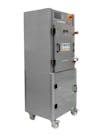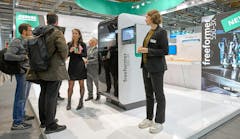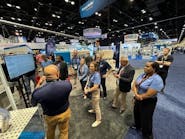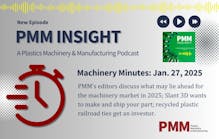Geisinger's 3-D lab helps health-care workers stay safe
By Bruce Geiselman
Geisinger, a regional health care system operating in Pennsylvania and New Jersey, turned to its 3-D printing lab when the COVID-19 pandemic struck, and personal protective equipment became hard to acquire.
Sarah Rimini, program director of Geisinger’s 3-D printing lab on the health system’s main campus in Danville, Pa., normally prints surgical aid tools and 3-D models of patients' body parts based on CT and MRI scans. As an example, printing a model of a patient’s aorta and heart to scale can help cardiac surgeons practice prior to surgery.
However, once the pandemic struck, Rimini started considering how her printers might help keep the system’s workers healthy.
“The first thing I designed was a door handle tool,” Rimini said. “It’s something you hold in your hand. Everyone gets their own, and it opens many doors. You can push buttons on elevators with it. It stopped the staff from touching anything or potentially spreading anything, and they’re easily cleanable, and you can put it back in your pocket.”
Rimini’s lab printed some, and a 3-D printing enthusiasts group in Pittsburgh, 3DPPGH, also printed the door handle tools for distribution throughout the Geisinger health system.
Soon, the health system faced a shortage of commercially produced face shields. Her lab began producing face shields based on plans she found online, but she quickly learned her lab couldn’t meet the demand.
“We were printing them, but we couldn’t keep up, obviously,” she said.
The lab printed the face shield headbands out of PET-glycol on Ultimaker 3-D printers and then attached transparency film to function as the shield.
Rimini reached out to MatterHackers, an Orange County, Calif.-based company that supplies 3-D printing materials and tools, which put Geisinger in touch with local makerspaces that wanted to help with Geisinger’s 3-D printing efforts.
In house, Geisinger printed about 10,000 face shields during the height of the pandemic, Rimini said. In total, about 60,000 to 70,000 shields were printed for the health system.
Geisinger’s lab also produced ear savers, devices that fasten mask loops behind the wearer’s head, relieving pressure on their ears.
Rimini also worked on a design for N95 mask replacement straps.
“A lot of our masks had to be reused and autoclaved since we had a shortage,” Rimini said. “The masks were fine, but the straps were deteriorating.”
Her lab began prototyping 3-D printed straps that would allow the masks to continue to be used. However, the hospital system never had to use the replacement straps.
“Those were designs to make sure that if we got to that point [of running out of N95 masks], we had a backup,” Rimini said.
Rimini was one of several participants in a recent webinar hosted by SME that examined how health care systems used 3-D printing to cope with supply chain interruptions during the pandemic.
Rimini can be reached at [email protected].
More on medical parts and plastics
Parts makers step up their processes to meet needs
Health-care market keeps IMM makers busy
Injection unit, machine dedicated for test tubes among new processing technologies
Extruder OEMs respond to changing medical landscape
Auxiliary makers prioritized medical orders during pandemic
Robots shine in clean room duties
Economist: Run on medical goods provided jolt to plastics manufacturers
University speedily designs and prints nasal swabs
Beckwood Press designs compression molding equipment for medical devices
Quick deliveries, new products: Husky details COVID-19 response
Bruce Geiselman | Senior Staff Reporter
Senior Staff Reporter Bruce Geiselman covers extrusion, blow molding, additive manufacturing, automation and end markets including automotive and packaging. He also writes features, including In Other Words and Problem Solved, for Plastics Machinery & Manufacturing, Plastics Recycling and The Journal of Blow Molding. He has extensive experience in daily and magazine journalism.






